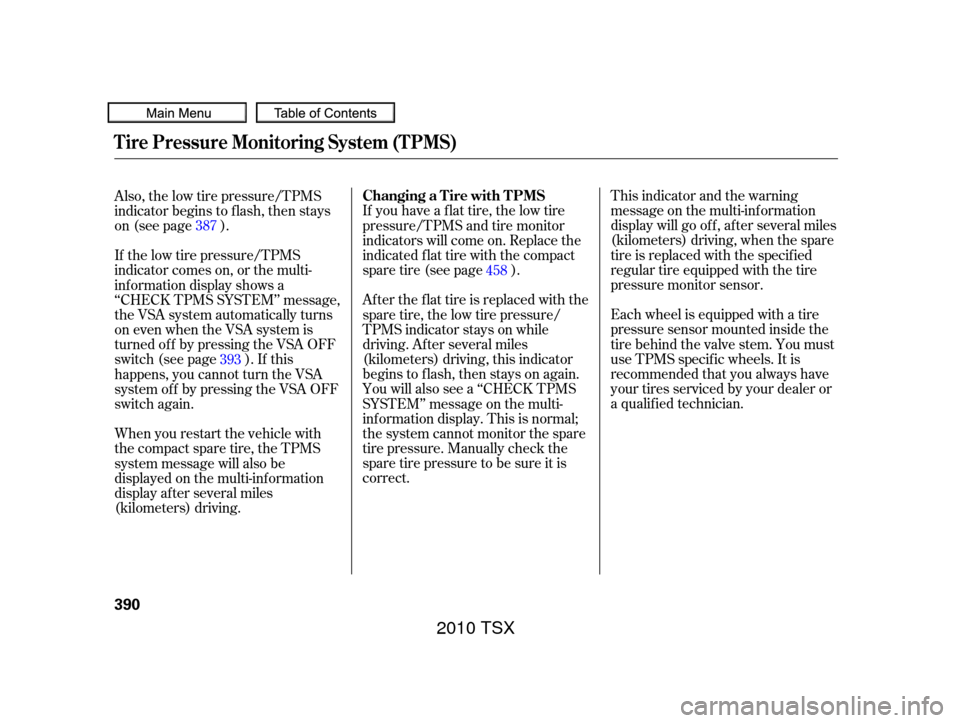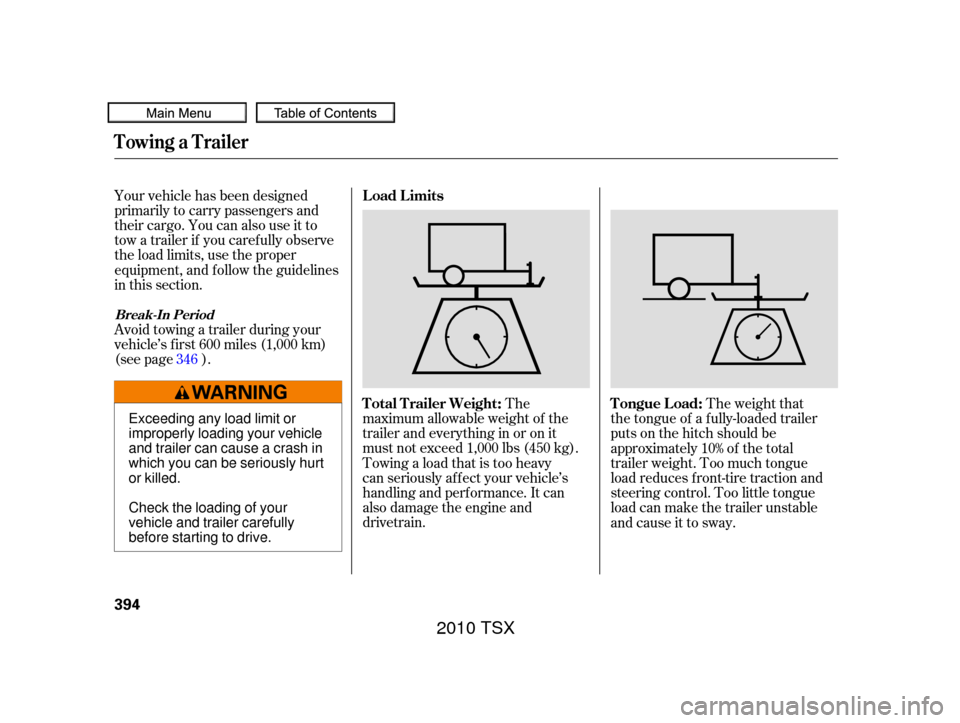Acura TSX 2010 Owner's Manual
Manufacturer: ACURA, Model Year: 2010, Model line: TSX, Model: Acura TSX 2010Pages: 524, PDF Size: 12.34 MB
Page 391 of 524

To see the inf lation pressures of all
f our tires, press the SEL/RESET
button. The display changes as
shown above.Each tire pressure is shown in PSI
(U.S. models) or in kPa (Canadian
models).
Each tire has its own pressure
sensor. If the air pressure of a tire
becomes signif icantly low, the
sensor in that tire immediately sends
a signal that causes the low tire
pressure/TPMS indicator in the
instrument panel to come on. If this
happens, you will see which tire is
losing pressure on the multi-
inf ormation display along with a
‘‘CHECK TIRE PRESSURE’’
message.
Tire Pressure Monitoring System (TPMS)
388
This shows that front left tire is
losing pressure.
U.S. model
Canadian model
2010 TSX
Page 392 of 524

If there is a problem with the TPMS,
you will see the above message on
the multi-information display.
If you see this message, the system
is of f and is not monitoring the tire
pressures. Have the system checked
by your dealer as soon as possible.
If there is a problem with the TPMS,
thetirepressuremonitorshowsa
‘‘SYSTEM FUNCTION ERROR’’
message and the tire pressure
readings are not displayed. If this
happens, you will f irst see a system
warning message ‘‘CHECK TPMS
SYSTEM’’ on the multi-inf ormation
display.
If any of the tires has low pressure,
thetirepressuremonitoralsoshows
the above message to warn you
about the low tire pressure when you
select the display by pressing the
INFO button several times.
Following this display, press the
SEL/RESET button to see each tire
pressure. When you continue driving
af ter installing the spare tire, you will
also see this message on the multi-
inf ormation display.
CONT INUED
TPMS System Failure
Tire Pressure Monitoring System (TPMS)
Driving
389
2010 TSX
Page 393 of 524

This indicator and the warning
message on the multi-inf ormation
display will go of f , af ter several miles
(kilometers) driving, when the spare
tire is replaced with the specified
regular tire equipped with the tire
pressure monitor sensor.
Each wheel is equipped with a tire
pressure sensor mounted inside the
tire behind the valve stem. You must
use TPMS specif ic wheels. It is
recommended that you always have
your tires serviced by your dealer or
a qualif ied technician.
If you have a f lat tire, the low tire
pressure/TPMS and tire monitor
indicators will come on. Replace the
indicated f lat tire with the compact
sparetire(seepage ).
After the flat tire is replaced with the
spare tire, the low tire pressure/
TPMS indicator stays on while
driving. Af ter several miles
(kilometers) driving, this indicator
begins to f lash, then stays on again.
You will also see a ‘‘CHECK TPMS
SYSTEM’’ message on the multi-
inf ormation display. This is normal;
the system cannot monitor the spare
tire pressure. Manually check the
sparetirepressuretobesureitis
correct.
Also, the low tire pressure/TPMS
indicator begins to f lash, then stays
on (see page ).
If the low tire pressure/TPMS
indicator comes on, or the multi-
inf ormation display shows a
‘‘CHECK TPMS SYSTEM’’ message,
the VSA system automatically turns
on even when the VSA system is
turned of f by pressing the VSA OFF
switch (see page ). If this
happens, you cannot turn the VSA
system of f by pressing the VSA OFF
switch again.
When you restart the vehicle with
thecompactsparetire,theTPMS
system message will also be
displayed on the multi-inf ormation
display af ter several miles
(kilometers) driving.
458
393
387
Tire Pressure Monitoring System (TPMS)
Changing a T ire with T PMS
390
2010 TSX
Page 394 of 524

As required by the FCC:This device complies with Part 15 of theFCC rules. Operation is subject to thef ollowing two conditions: (1) This devicemay not cause harmf ul interf erence, and(2) this device must accept anyinterf erence received, includinginterf erence that may cause undesiredoperation.
Changes or modif ications not expresslyapproved by the party responsible f orcompliance could void the user’sauthority to operate the equipment.
This device complies with IndustryCanada Standard RSS-210.Operation is subject to the f ollowing twoconditions: (1) this device may not causeinterf erence, and (2) this device mustaccept any interf erence that may causeundesired operation of the device.Never use a puncture-repairing agent
in a f lat tire. If used, you will have to
replace the tire pressure sensor.
Havetheflattirerepairedbyyour
dealer as soon as possible.
If the low tire pressure/TPMS
indicator and the low tire position on
the low tire pressure monitor do not
go out after inflating the tires to the
specified values, have your dealer
check the system as soon as possible.
Tire Pressure Monitoring System (TPMS)
Driving
391
2010 TSX
Page 395 of 524

The vehicle stability assist (VSA)
system helps to stabilize the vehicle
during cornering if the vehicle turns
more or less than desired. It also
assists you in maintaining traction
while accelerating on loose or
slippery road surf aces. It does this
by regulating the engine’s output and
by selectively applying the brakes.
When VSA activates, you may notice
that the engine does not respond to
the accelerator in the same way it
does at other times. There may also
be some noise f rom the VSA
hydraulic system. You will also see
the VSA activation indicator blink.
The VSA system cannot enhance the
vehicle’s driving stability in all
situations and does not control your
vehicle’s entire braking system. It is
still your responsibility to drive and
corner at reasonable speeds and to
leave a sufficient margin of safety.When VSA activates, you will see the
VSA Activation indicator blink.
If this indicator comes on while
driving, pull to the side of the road
when it is saf e, and turn of f the
engine. Reset the system by
restarting the engine. If the VSA
system indicator stays on or comes
back on while driving, have the VSA
system inspected by your dealer.
If the indicator does not come on
when the ignition switch is turned to
the ON (II) position, there may be a
problem with the VSA system. Have
your dealer inspect your vehicle as
soon as possible.
When the VSA system indicator
comes on, you will also see a
‘‘CHECK VSA SYSTEM’’ message
on the multi-information display.
The main f unction of the
VSA system is generally known as
Electronic Stability Control (ESC).
The system also includes a traction
control f unction.
If the low tire pressure/TPMS
indicator comes on (see page ),
or the multi-information display
shows a ‘‘CHECK TPMS SYSTEM’’
message with the indicator flashing
(see page ), the VSA system
automatically turns on even if the
VSA system is turned off with the
VSA OFF switch. In this case, you
cannot turn the VSA system of f by
pressing the VSA OFF switch again. 389
386
VSA A ctivation Indicator
Vehicle Stability Assist
(VSA ) System Indicator
Vehicle Stability A ssist (VSA), aka Electronic Stability Control (ESC), System
392
NOTE:
2010 TSX
Page 396 of 524

Driving with varying tire or wheel
sizes may cause the VSA to
malf unction. When replacing tires,
make sure they are of the same size
and type as your original tires (see
page ).
If you install winter tires, make sure
they are the same size as those that
were originally supplied with your
vehicle. Exercise the same caution
during winter driving as you would if
your vehicle was not equipped with
VSA.
Immediately af ter f reeing your
vehicle, be sure to switch the VSA on
again. We do not recommend driving
your vehicle with the VSA and
traction control systems switched off. In certain unusual conditions when
your vehicle gets stuck in shallow
mud or f resh snow, it may be easier
to free it with the VSA temporarily
switched of f . When the VSA system
is of f , the traction control system is
alsooff.Youshouldonlyattemptto
f ree your vehicle with the VSA of f if
you are not able to f ree it when the
VSA is on. VSA is turned on every time you
start the engine, even if you turned it
off the last time you drove the
vehicle.
When VSA is off, the VSA activation
indicator comes on as a reminder. Press and hold the switch again. It
turns the system back on.
This switch is under the driver’s side
vent. To turn the VSA system on and
of f , press and hold it until you hear a
beep. Without VSA, your vehicle will have
normal braking and cornering ability,
but it will not have VSA traction and
stability enhancement. 451
VSA and Tire Sizes
VSA OFF Switch
Vehicle Stability A ssist (VSA), aka Electronic Stability Control (ESC), System
Driving
393
VSA OFF SWITCH
2010 TSX
Page 397 of 524

Your vehicle has been designed
primarily to carry passengers and
their cargo. You can also use it to
tow a trailer if you caref ully observe
the load limits, use the proper
equipment, and f ollow the guidelines
in this section.The
maximum allowable weight of the
trailer and everything in or on it
must not exceed 1,000 lbs (450 kg).
Towing a load that is too heavy
can seriously af f ect your vehicle’s
handling and perf ormance. It can
also damage the engine and
drivetrain. The weight that
the tongue of a f ully-loaded trailer
puts on the hitch should be
approximately 10% of the total
trailer weight. Too much tongue
load reduces front-tire traction and
steering control. Too little tongue
load can make the trailer unstable
and cause it to sway.
Avoid towing a trailer during your
vehicle’s f irst 600 miles (1,000 km)
(see page ).
346 Load Limits
T otal T railer Weight:
T ongue L oad:
Towing a Trailer
Break-In Period
394
Exceeding any load limit or
improperly loading your vehicle
and trailer can cause a crash in
which you can be seriously hurt
or killed.
Check the loading of your
vehicle and trailer carefully
beforestartingtodrive.
2010 TSX
Page 398 of 524

To achieve a proper tongue load,
start by loading 60% of the load
toward the front of the trailer and
40% toward the rear, then re-adjust
the load as needed.The maximum allowable weight of
the vehicle axles is:
The maximum allowable weight of
the vehicle, all occupants, all
accessories, all cargo, and the
tongue load is: Thebestwaytoconfirmthatall
loads are within limits is to check
them at a public scale. For public
scales in your area, check your local
phone book, or contact your trailer
dealer or rental agency for
assistance.
If you cannot get to a public scale,
you can estimate the total trailer
weight by adding the weight of your
trailer (as quoted by the
manuf acturer) with everything in or
on the trailer.
If you normally pull the same load
each time you tow a trailer, you can
use a suitable scale or a special
tongue load gauge to check the
tongue load the f irst time you set up
a towing combination (a f ully loaded
vehicle and trailer), then recheck the
tongue load whenever the conditions
change.
on the f ront axle
on the rear axle
on the f ront axle
on the rear axle
on the rear axle on the f ront axle
Manual transmission:
Automatic transmission:
Manual transmission:
Automatic transmission:
Checking L oads
Gross Axle Weight Rating
(GA WR):
Gross Vehicle Weight Rating
(GVWR):
4-cylinder models 4-cylinder models
6-cylinder models 6-cylinder models
Towing a Trailer
Driving
395
4,395 lbs (1,995 kg) 4,475 lbs (2,030 kg)
2,090 lbs (950 kg) 2,325 lbs (1,055 kg) 2,090 lbs (950 kg) 2,410 lbs (1,095 kg)
4,630 lbs (2,100 kg) 2,557 lbs (1,160 kg)
2,083 lbs (945 kg)
2010 TSX
Page 399 of 524

Any hitch used on your vehicle must
be properly bolted to the underbody.
Always use saf ety chains when you
tow a trailer. Make sure the chains
are secured to the trailer and hitch,
and that they cross under the tongue
and can catch the trailer if it
becomes unhitched. Leave enough
slack to allow the trailer to turn
corners easily, but do not let the
chains drag on the ground.
Towing can require a variety of
equipment, depending on the size of
your trailer, how it will be used, how
much load you are towing, and
where you tow.
If you choose electric brakes, be
sure they are electronically actuated.
Do not attempt to tap into your
vehicle’s hydraulic system. No
matter how successf ul it may seem,
any attempt to attach trailer brakes
to your vehicle’s hydraulic system
will lower braking ef f ectiveness and
create a potential hazard.
See your trailer dealer or rental
agency f or more inf ormation on
installing electric brakes.
Discuss your needs with your trailer
sales or rental agency, and f ollow the
guidelines in this section. Also make
sure that all equipment is properly
installed and maintained, and that it
meets f ederal, state, province,
territory, and local regulations. To ensure the best quality, we
recommend that you purchase Acura
equipment whenever possible. There are two common types of
trailer brakes: surge and electric.
Surge brakes are common f or boat
trailers, since the brakes will get wet.
T owing Equipment and
A ccessories
Trailer Brakes
Hitches
Saf et y Chains
Towing a Trailer
396
2010 TSX
Page 400 of 524

Many states and Canadian
provinces/territories require special
outside mirrors when towing a trailer.
Even if they don’t, you should install
special mirrors if you cannot clearly
see behind you, or if the trailer
creates a blind spot.
Trailer lights and equipment must
comply with f ederal, state, province,
territory, and local regulations.
Check with your local trailer sales or
rental agencies f or the requirements
in the area where you plan to tow,
and use only equipment designed f or
your vehicle.
Since lighting and wiring vary by
trailer type and brand, you should
have a qualif ied technician install a
suitable connector between the
vehicle and the trailer. Improper
equipment or installation can cause
damage to your vehicle’s electrical
system and af f ect your vehicle
warranty. When preparing to tow, and bef ore
driving away, be sure to check the
f ollowing:
The trailer has been properly
serviced and is in good condition.
Thehitch,safetychains,andany
other attachments are secure.
All items in or on the trailer are
properly secured and cannot shif t
while you drive. All weights and loads are within
limits. The vehicle has been properly
serviced, and the suspension and
the cooling system are in good
operating condition.
Askyourtrailersalesorrental
agency if any other items are
recommended or required f or your
towing situation.
CONT INUED
T railer L ight s A ddit ional T owing Equipment
Towing a Trailer
Pre-T ow Checklist
Driving
397
2010 TSX